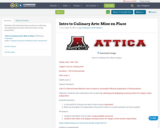
Students will understand mise en place by collecting and displaying necessary items for today’s recipe preparation.
- Subject:
- Career and Technical Education
- Material Type:
- Activity/Lab
- Date Added:
- 07/16/2017

Students will understand mise en place by collecting and displaying necessary items for today’s recipe preparation.

This course gives an overview of integrated pest management focusing on corn and soybeans and introducing the basics of scouting, plant pathology, management of insects, diseases, and weeds, and discusses pesticides and human and environmental topics related to their use.
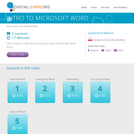
Do you want to learn the basics of how to use Microsoft word? This web site offers easy to understand video lessons. In addition to the audio lessons, the site offers supplement materials.

This resource was created by Alison Pavelka, in collaboration with Dawn DeTurk, Hannah Blomstedt, and Julie Albrecht, as part of ESU2's Integrating the Arts project. This project is a four year initiative focused on integrating arts into the core curriculum through teacher education, practice, and coaching.

In this lesson students will explore the idea of irony in The Crucible as well as in modern-day memes and use this to create their own ironic meme related to The Crucible.
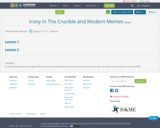
In this lesson students will explore the idea of irony in modern day memes and use this to create their own ironic meme related to The Crucible.
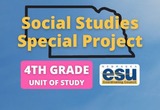
Is Native American culture Nebraska culture? This inquiry lesson will educate fourth graders about the Native American culture that still exists in Nebraska, with a focus on the Umóⁿhoⁿ (Omaha) Tribe of Nebraska since the writer is familiar with the culture and they are the only Nebraska Tribe not relocated. Resource created by Brent Wojcik, Omaha Nation High School, as part of the Nebraska ESUCC Social Studies Special Projects 2024 - Inquiry Design Model (IDM).
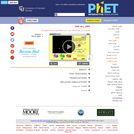
Are all atoms of an element the same? How can you tell one isotope from another? Use the sim to learn about isotopes and how abundance relates to the average atomic mass of an element.
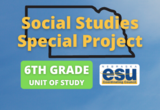
Whose Land is it? An exploration of who rightfully should claim the land being fought over by Israel and Palestine. Resource created by Jonathan Meyer, Gothenburg Public Schools, as part of the Nebraska ESUCC Social Studies Special Projects 2024 - Inquiry Design Model (IDM).
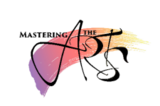
This resource was created by Michele Barcelona, in collaboration with Lynn Bowder, as part of ESU2's Mastering the Arts project. This project is a four year initiative focused on integrating arts into the core curriculum through teacher education and experiential learning.

It's Your Paycheck! is designed for use in high school personal finance classes. The curriculum contains three sections: "Know Your Dough," "KaChing!" and "All About Credit." The lessons in each of these sections employ various teaching strategies to engage students so that they have opportunities to apply the concepts being taught. Each lesson includes black-line masters of the handouts and visuals needed to teach the lesson.
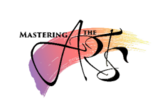
This resource was created by Staci Simonsen, in collaboration with Lynn Bowder, as part of ESU2's Mastering the Arts project. This project is a four year initiative focused on integrating arts into the core curriculum through teacher education and experiential learning.
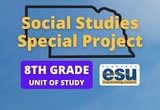
Students will examine the relationships between the Jamestown Settlers and Powhatan indigenous people. They will explore the different perspectives of these two groups of people and why their views clashed with one another. But were the Powhatans' actions justified?Through this inquiry, students will explore multiple resources, complete tasks, and answer questions that will show if the Powhatan Indians were justified in their response to the Jamestown settlers.Resource created by Lucas Spooner, Winnebago Public Schools, as part of the Nebraska ESUCC Social Studies Special Projects 2022 - Inquiry Design Model (IDM).

This resource is designed to enhance oral proficiency and remain in the language of instruction with some guideposts in English since it's a novice-low task.
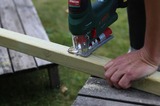
The jig saw is an important tool/piece of equipment used in woodworking. In this set of lessons, students will identify the parts of a jig saw, describe the safety hazards associated with the jig saw, and demonstrate the steps to operating the jig saw. This lesson will consist of a PowerPoint lecture, notes, video, teacher demonstration, student demonstration, safety quiz, and student performance assessment.
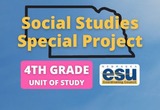
This inquiry focuses on the intent of the Kansas-Nebraska Act and its importance in the construction of the transcontinental railroad. Students will explore multiple resources, complete tasks, and answer questions that will show the intent of the Kansas-Nebraska Act and its impacts on the United States. Resource created by Jenna Schawang, Falls City Sacred Heart, as part of the ESUCC Nebraska Social Studies Project 2022 - Inquiry Design Model (IDM).

This lesson allows students to practice capsizing in a safe environment. They will also learn how to perform self rescues and partner rescues to get back into their kayak once they have capsized.

Three-minute video phenomena for the Kentucky Blue people. A great introduction to the passing of traits via sexual reproduction including Punnett squares and dominant and recessive traits.

The attached Lesson Plan is designed for Third Grade English Language Arts students. Students will determine story elements and use the elements to write a summary. This Lesson Plan addresses the following NDE Standard: NE LA 3.1.6.b and NE LA 3.1.6.dIt is expected that this Lesson Plan will take students 90 minutes to complete.

Throughout this project, the students will construct a kitchen pot holder. This project will take about six to seven days (45-minute class periods, with 22 students) for students to complete. Everyday, students will begin with setting up their sewing machines and setting goals for the day. Students will follow the written and video instructions to complete the project. At the end of each day, students will reflect upon what they accomplished and what they hope to improve upon for the following day. As there are written and video instructions, students can move through the project at their own pace. This project works well for middle school (specifically 6th grade) or as a project to refresh students on how to use the sewing machine and construction terminology in high school.